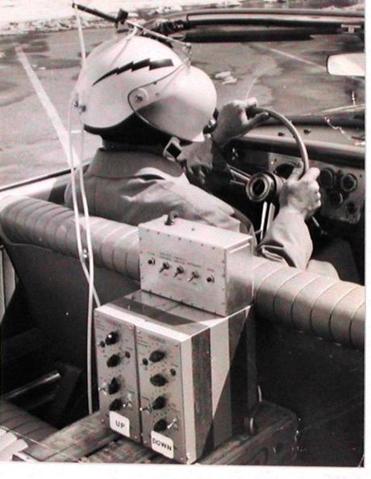what was the first state to ban drivers from talking on cell phones while drivin?a
Distracted driving has been effectually longer than you call back
Early on examples of distracted driving studies go back every bit far every bit 1963, when scientist John Senders took to the roads blindfolded – all in the name of enquiry.

The notion of distracted driving goes as far back equally the invention of the car itself. At that place take ever been external distractions – like billboards or people on the side of the road. Internal distractions are nothing new, either – tuning a radio, lilliputian with the A.C., reaching for a french fry or parenting from the front seat.
The pioneer of distracted driving

Early on examples of distracted driving studies go dorsum as far every bit 1963, when scientist John Senders took to the roads blindfolded – all in the name of research. The Bureau of Public Roads (now the Federal Highway Administration) tasked him with investigating how much time a commuter had to spend looking at the roads to drive finer. To gather his needed information, Senders hopped into a Contrivance Polara and drove into midday traffic on I-495 in Massachusetts.
The twist: he was wearing a motorcycle helmet with a sandblasted opaque shield, which was rigged to a sensor that periodically flipped it downward over his eyes. With the visor down, Senders could meet nothing until he triggered it to elevator again for a fraction of a second.
Senders' findings were indicative of the hereafter. He wrote in a report published in 1967 about the phenomenon of "road hypnotization" – staring at the road ahead, only not actually seeing it. Senders noted a plethora of distractions tugging at drivers' focus, including the rearview mirror, conversing with a passenger and checking out landmarks.
This study led him to develop the "occluded vision paradigm equally a measure of attentional need" (now a part of the protocol for cess of lark). This technique is all the same used today in driving studies, and has a long and diverse history of applications, including its use in the development of instrument panel designs in plane cockpits.
Senders won an Ig Nobel Prize in Public Prophylactic in 2011 for his study, "The Attentional Demand of Auto Driving." He died in 2019 at the age of 99.
The arrival of cellphones
If only Senders had known what was coming next.
In 1983, something arrived on the scene that drastically inverse the definition of "distracted driving." That year, cellular telephones were introduced to the American marketplace.
By 1997, the Cellular Telecommunications Manufacture Association (CTIA) reported that there were more than 50 million cellular customers in the U.S. That same yr, the National Highway Traffic Safety Administration (NHTSA) launched one of the first intensive studies into the effects of wireless phones on driving.
Amongst those surveyed, nine out of 10 cellular phone owners reported using them while driving. This study also surveyed the effects of driving and using a cellphone (inability to maintain speed, lane drifting and weaving). The written report highlighted comments by police force officers, who were seeing an increased amount of odd beliefs on the roads in conjunction with cellphone usage.
According to AT&T, today more than xc percent of people say they know the dangers of texting and driving, notwithstanding many still discover ways to rationalize their behavior.
Police force enforcement takes action
Florida became the first state to ban the apply of any sort of mobile communications device with a law against using headsets, headphones or any other listening device in 1992. Arizona followed presently subsequently in 1996, with restrictions on the use of hand-held and/or hands-free communication devices by school drivers.
In 2001, several other states (New Jersey, Illinois, Massachusetts and New York) followed suit, enacting diverse bans on communications devices while driving. New York was the very start state to restrict the employ of mitt-held devices past all drivers.
Kentucky's first constabulary regarding distracted driving and cellphone usage was passed in 2007. It restricted the utilise of hand-held or hands-costless devices by school omnibus drivers. On April 15, 2010, the Democracy Firm Neb 415 was signed into police force, banning texting for drivers of all ages while a vehicle is in motion.
Today
In 2011, the number of wireless subscriber connections in the U.S. (315.9 million) surpassed the population (315.5 million), according to CTIA. Today, more than than 98% of Americans own a mobile phone.
Currently, talking on a hand-held cellphone while driving is banned in 24 states, D.C., Puerto Rico, Guam and the U.S. Virgin Islands. Thirty-eight states and D.C. ban all cellphone utilize by novice or teen drivers, and 21 states and D.C. prohibit any cellphone use for schoolhouse bus drivers.
Text messaging is banned for all drivers in 48 states (including Kentucky) and D.C., Guam, and the Virgin Islands.
Click here to check out your state's laws regarding cellphone usage
In Kentucky, at that place is a texting ban. No laws currently restrict talking on a hand-held phone behind the wheel. Drivers younger than 18 and school motorbus drivers are under an "all cell telephone ban," which means these two groups are prohibited from whatsoever prison cell phone usage, including making hand-held phone calls.
The enforcement of these laws is "main" in Kentucky, meaning a police officeholder may pull over and ticket a commuter if he or she simply observes a violation in activity.
In a gild of increasingly unlimited availability, it'south obvious that this problem isn't going away anytime presently. Don't permit a smiley face emoji be the reason you get a ticket – or worse. Please drive distraction free.
>> In Kentucky, there'due south so much to alive for. Join us in driving distraction-complimentary.
To learn more well-nigh distracted driving's prevalence in the Bluegrass State, click here.
Source: https://www.kyfb.com/insurance/lifes-blueprints/distracted-driving-has-been-around-longer-than-you-think/
0 Response to "what was the first state to ban drivers from talking on cell phones while drivin?a"
Post a Comment